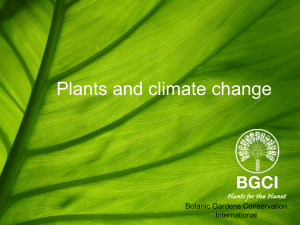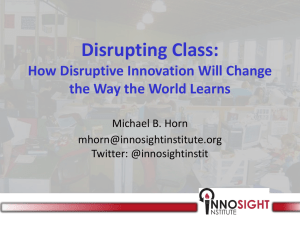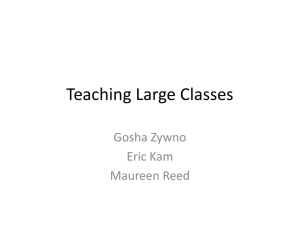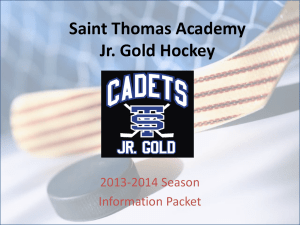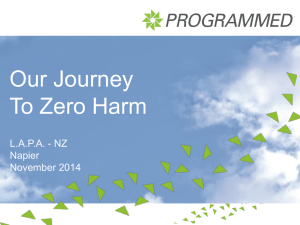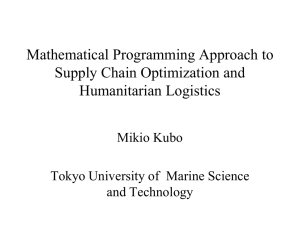File - Goal Disruption Theory
advertisement
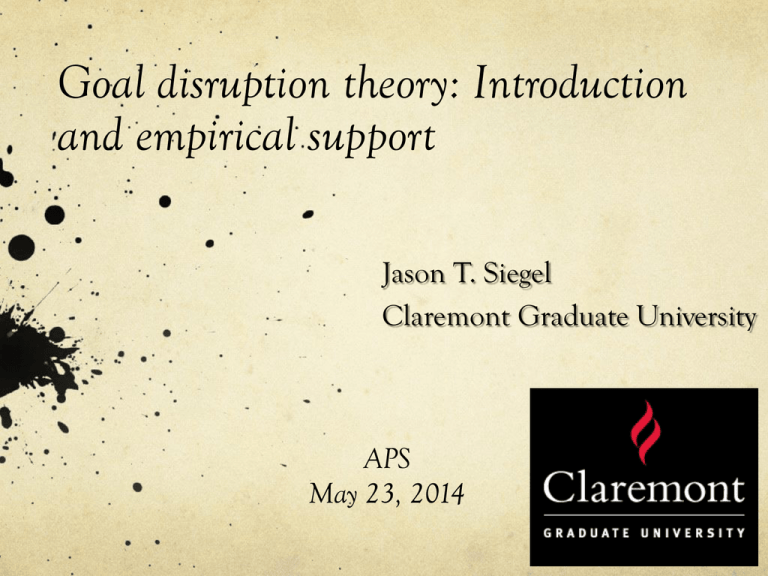
Goal disruption theory: Introduction and empirical support Jason T. Siegel Claremont Graduate University APS May 23, 2014 Collaborators Benjamin Rosenberg Mario Navarro Elena Lyrintzis Lindsay Handren Acknowledgment Dr. Bill Crano See GDTheory.com for the full presentation. Edward C. Tolman Tolman = the spark. Behavior is purposive “…[it] always seems to have the character of getting-to or getting-from a specific goal-object, or goal-situation” (Tolman, 1932, p. 10) The causes of behavior are environmental stimuli and initiating physiological states. Changes in thought and action are system-wide. Disruption Edward C. Tolman Organisms develop “cognitive expectations” for stimuli or behavior to lead to more or less reward A mouse, an ape, some lettuce. When these expectations are violated, disruption occurs. Tolman presented disruption as an upset in behavior caused by environmental change, leading the organism to focus on the cause of the disruption. Disruption Could this explain some behavior typically perceived as irrational and foolish? What are the totality of changes that occur? What dictates whether a violation will lead to disruption? What is GDT? Goal disruption theory (GDT, see Siegel, 2013; Siegel et al., 2012) seeks to explain the factors (e.g., strength of the expectation that was violated) that influence whether negatively valenced goal expectancy violations (e.g., learning resources for goal satiation are less than expected) will cause disruption, and the breadth of changes that occur as a result (e.g., increased need for structure, willingness to endure harm). Goal Disruption Theory Behavior is goal directed and purposive. Disequilibrium is a motivational state that triggers the psychological system to adjust to maximize a return to equilibrium. Goal expectancy violations represent a cause of a state of disruption (persistent state of psychological disequilibrium). Definitions Goals •“…the desired end state the individual reaches for; it is the ultimate aim of one’s adopted action, the very cause of the action; it is the purpose toward Moskowitz and which one is striving; it is the reason Grant (2009) define for doing and thinking” (p. 1). goals as follows: Expectations Tolman (1932) defines expectations as follows: •“an immanent cognitive determinant aroused by actually presented stimuli” (Tolman, 1932, p. 444). Tolman (1925, 1932) theorized extensively on the importance of expectations (i.e., beliefs an individual holds about his or her world and how the components of the world interact) and the role they play in goal pursuit and the maintenance of psychological equilibrium. Goal Expectations Beliefs about rewards associated with specific goals. Paths through which the goal can be achieved. Peoples’ capabilities for achieving the goal. Skills that will be needed for achieving the goal. Level of performance they can expect to achieve from the self as well as from other people and environmental objects. Resources and support that exist for achieving the goal. Situations that will be encountered as the result of goal-related behavior. People hold expectations about the goals they have already accomplished and the distance remaining between themselves and the goal. Goal Expectation Violations If people hold expectations about their goals, occurrences will transpire that violate those expectations (i.e., goal expectation violations). Goal expectation violations can make the world seem less predictable and less controllable than previously believed Appraisals of threat and feelings of vulnerability are amplified (e.g., Rosenberg et al., in press; Siegel et al., 2012; Tolman, 1932; also see Pyszczynski & Greenberg, 1981). Goal Disruption A persistent state of psychological disequilibrium that occurs as a result of a goal expectation violation. Theoretical Model Structural Harmony Violation Ability Imprint Opinion of Efficacy Processing Personality Traits & Perception Disposition Disruption Violation Severity Disruption Goal State Allocation Tactic of Mental Resources Seeks to explain the factors that influence whether a goal expectancy violations will cause disruption. Seeks to understand the breadth of changes that occur as a result Mental Constriction Unexpected Goal Violation Violation Severity Ability Violation Imprint Disposition Opinion of Efficacy DISRUPTION (persistent psychological disequilibrium) Allocation of Resources Structural Harmony Processing and Perception Personality Traits Tactic Predicting Goal Disruption Violation Severity Strength The strength of the violated expectations/beliefs, and goal status. Goal Status Closeness to goal, effort into goal, and goal magnitude. Unexpected Nature The level of unexpectedness of the goal expectation violation. Predicting Goal Disruption Violation Imprint The number of impaired expectancies and the perceived importance of the goal to the person’s well being. Opinion of Efficacy An individual's perceived capabilities of finding an alternative path to restore their feelings of safety. Structural Harmony (State of the System) Current psychological state, organization, flexibility. Personality Traits Traits that buffer the intensity of a violation (i.e., tolerance of uncertainty, trait anxiety). If a goal disruption occurs… Mental constriction A return to equilibrium becomes paramount focus System-wide adaptive processes engage (for similar conceptualization see Arndt & Solomon, 2003; Barker, Dembo, & Lewin, 1941; Berkowitz, 1988, 1989; Lewin, 1946) Psychological disequilibrium will persist until psychological balance is restored (Kessen, 1971; Tolman, 1926). ADAPT Ability Reduced goal fluidity Less creativity Reduced ability to focus on other goals Disposition Increased need for closure Changes in temperament Less inclined to take another person’s perspective Allocation of Resources Goal Shielding Little to no concern for problems caused by shifting resources away from other goals Processing & Perception Attention bias toward relevant stimuli Hyper-focus on goal Tunnel vision Tactics Behavior will become more primitive Most direct path toward goal Long term consequences not considered Why care? Explain behavior previously regarded as irrational. Offers an explanation for extreme behavior. Makes it very scary to think about medical decisions made after receiving bad news. Offers insight into why interventions sometimes fail (decision are made while in a state of disruption). Empirical Evidence O-HITS: • Start with evidence that unexpected negative goal violations cause more psychological disequilibrium than expected negative goal violations. ADAPT: • Begin with purposive harm endurance. • Highlight how a negative goal violation changes numerous constructs not often considered as a system-wide response. So what? Study Set 1 Structural Harmony To experimentally test the factors of the individual Opinion Violation that cause a goal Goal of Efficacy Imprint expectation violation to become a goal disruption. Violation Severity Disruption Personality Traits Will a goal violation become a goal disruption? Studies 1a-1c Dependent Variable Psychological Disequilibrium • Siegel & Lyrintzis (under review) • Level of disruption experienced • 5 items: “I am mentally uneasy,” “I have lost my psychological center” Study 1a Participants Informed Consent MTurk Study N = 333 Pretest measure of intolerance of uncertainty Compensated $0.51 Randomly assigned to intense or minor goal violation Posttest measure of PDQ Thanked and debriefed Study 1a Intense vs. Minor goal violation Pilot tested [N = 75; t(74) = 4.75, p < .001, d = 1.10] Outcome of job interview Manipulated factors Bad vs. good week (structural harmony) Prepared vs. did not prepare (strength) Need job vs. don’t need job (imprint) Confident vs. not confident (severity) Study 1a Measure Intolerance of Uncertainty •Buhr & Dugas (2003) •Assess if participants are comfortable with unstructured surroundings •27 items: “Unforeseen events upset me greatly,” “One should always look ahead so as to avoid surprises” Study 1a Significant interaction between violation and IUS: B = -.34, t(329) = -2.54, p = .01 ✔ 7 Mean PDQ 6 5 Intense Minor 4 3 2 1 1 SD - Mean Intolerance of Uncertainty 1 SD + Study 1b Participants Informed Consent Mturk sample N = 308 Compensated $0.51 Pretest measure of general self-efficacy Randomly assigned to intense or minor goal violation Posttest measure of PDQ Thanked and debriefed Study 1b Measure General self-efficacy •Schwarzer & Jersulam (1981) •Individual’s beliefs in ability to control challenging demands •10 items: “I can always manage to solve difficult problems if I try hard enough,” “I can usually handle whatever comes my way” Study 1b Significant interaction between violation and GSE: B = .46, t(302) = 2.52, p = .01 ✔ 7 Mean PDQ 6 5 Intense 4 Minor 3 2 1 1 SD (-) Mean General Self-Efficacy 1 SD (+) Study 1c Participants MTurk Study Informed Consent Pretest measures: optimism and need for structure N = 90 Compensated $1.00 Randomly assigned to unexpected or expected academic failure Posttest measure of PDQ Thanked and debriefed Study 1c Unexpected vs. Expected academic failure Waiting to take an important test All students imagine failing Expect to pass vs. Expect to fail Study 1c Measures Optimism •Scheier et al. (1994): Revised Life Orientation Test •Distinguish optimism from neuroticism •6 items: “In uncertain times, I usually expect the best” and “I hardly ever expect things to go my way (R).” Need for Structure •Thompson, Naccarato, & Parker (1989, 1992) •Dispositional changes •12 items: “It upsets me to go into a situation without knowing what I can expect from it” “I don’t like situations that are uncertain.” Study 1c Significant interaction between violation and Optimism: B = .48, t(89) = 2.05, p = .04 ✔ 7 Mean PDQ 6 5 4 Unexpected Expected 3 2 1 SD (-) Mean Optimism SD (+) Study 1c Significant interaction between violation and NFS: B = -.97, t(89) = -2.13, p = .04 ✔ 7 Mean PDQ 6 5 4 Unexpected Expected 3 2 1 SD (-) Mean Need for Structure SD (+) Study Set 1, Summary Intolerance of uncertainty, self-efficacy, optimism, and need for structure are all moderators of goal disruption Personality traits moderate whether a goal expectation violation leads to goal disruption Personality traits Even when confronted with an intense goal violation, having certain personality traits can buffer the likelihood of experiencing a goal disruption. Goal Expectation violation Disruption Study Set 2 Ability Opinion Processing of Efficacy & Perception Goal Violation Severity Structural Harmony Violation To experimentally test the GDT Imprint Disposition derived prediction that goal expectation violations lead to Disruption intense system-wide changes in thought and action. Disruption Tactic Allocation of Mental Resources Personality Traits Study Set #2 2a: Pay cut Unexpected vs. Expected Violation on PDQ Threat Appraisal Vulnerability 2b: Unexpected vs. Expected Violation on Ability: Self-reported Creativity Disposition: Personal Need for Structure Tactics: Purposive Harm Endurance 2c: Unexpected vs. Expected Violation on Allocation of resources: Goal Reengagement/Goal Disengagement Perception and processing: Goal Rumination Study 2a Methods: Informed Consent MTurk Study 211 Participants Randomly assigned to unexpected or expected goal violation Posttest measures of PDQ, Appraisal, Vulnerability Thanked and debriefed Study 2a Unexpected vs. Expected pay cut Imagine you are in Jessie’s position You receive a one percent pay cut Unexpected (completely surprised) vs. Expected (not surprised) Study 2a Measure Psychological disequilibrium Threat appraisal Vulnerability •Siegel & Lyrintzis (under review). •Assesses level of instability and psychological disequilibrium. •5 items: “I am mentally uneasy”, “I have lost my psychological center.” •Ferguson, Matthews & Cox (1999). •Assesses level of threat that an individual prescribes a situation. •6 items: “This event was…” Followed by items including “hostile” and “frightening.” •Assesses level of an individual’s feeling of vulnerability. •3 items: “vulnerable,” “open to harm,” and “unprotected.” Study 2a 7 Mean Response 6 5 4 F(3,208) = 7.64, p < .001, Cohen’s d = .38 Unexpected Expected 3 2 1 0 PDQ Threat Appraisal Vulnerability Study 2b Methods: Informed Consent MTurk Study 158 Participants Randomly assigned to an expected or unexpected goal violation Posttest measure of personal need for structure, creativity, purposive harm endurance Thanked and debriefed Study 2b Unexpected vs. Expected academic failure Waiting to take an important test All students imagine failing Expect to pass vs. Expect to fail Study 2b Measures Personal need for structure • Thompson, Naccarato, and Parker (1989, 1992). • Assesses peoples’ propensity to want organization and order within their lives. • 12 items: “It upsets me to go into a situation without knowing what I can expect from it.” Creativity • Forgeard (2013). • Assesses self-reported creativity. • 3 items: “Right now I feel…” and was followed by the words “creative,” “less creative than normal,” and “more creative than normal.” Study 2b Measure Physical purposive harm endurance •Assesses willingness to endure physical harm to pursue a goal. •4 items: “I would be willing to physically harm myself if it would lead to academic success” and “I would be willing to endure harm if I thought it would lead to academic success.” Interpersonal and emotional purposive harm endurance •Assesses willingness to endure interpersonal and emotional harm to pursue a goal. •4 items: “I would be willing to get emotionally hurt if I thought it would lead to academic success,” and “I would be willing to lose friends if it led to academic success.” Study 2b 7 Mean Response 6 5 F(4, 152) = 4.41, p = .002; Cohen’s d = .33 4 3 Unexpected 2 Expected 1 0 Study 2c Participants Informed Consent MTurk Study 158 Participants Randomly assigned to an expected or unexpected goal violation Posttest measure of goal adjustment scale (goal disengagement and goal reengagement) and goal rumination Thanked and debriefed Study 2c Unexpected or Expected Elimination of Bonus Waiting to hear about a monthly bonus Email saying you did not receive the bonus Unexpected (surprised) vs. Expected (not surprised) Study 2c Measure Goal reenegagement • Wrosch, Scheier, Miller, Schulz, & Carver (2003). • Assesses participants’ level of commitment to other goals. • 6 items: “I start working on other new goals,” and “I put effort toward other meaningful goals.” Goal disengagement • Wrosch, Scheier, Miller, Schulz, & Carver (2003). • Used to measure the loss of the ability to reduce effort toward a different goal or to work on other goals. • 4 items: “I stay committed to the goal for a long time; I can’t let go,” and “It’s easy for me to stop thinking about the goal and let it go.” Study 2c Measure Goal rumination •Brunstein, Schultheiss, and Grässmann (1998). •This scale measures participants’ tendency to think continuously about their goals. •7 items: “I go round and round in my mind about this goal,” and “I find it hard to shut off thoughts about this goal.” Study 2c 7 Mean Response 6 5 F(3,62) = 3.56, p = .002; Cohen’s d = .47 4 Unexpected Expected 3 2 1 0 Goal rumination Goal disengagement Goal reengagement Study Set 2, Summary Unexpected vs. Expected Violation PDQ, Threat, Vulnerability Changes in Unexpected vs. Expected Violation •Ability •Disposition •Allocation of Resources •Processing and Perception •Tactic Study Set 3 Ability Processing & Perception Disposition To test the applied utility of GDT within the Disruption contexts of politics, drug use, and alcohol myopia. Goal Tactic Allocation of Mental Resources Study Set #3: Application of GDT •Are people who are most surprised about a negative election result 3a-b: Harm most likely to endure harm to change the outcome? for Romney 3c-3d: Disrupted Drug Use 3e-3f: Disruption Myopia •Can GDT offer insight into why non-users of prescription stimulants decide to initiate use? •Can GDT offer insight into how drug ads influence peoples’ processing and perception? •Does processing in a state of disruption mimic that of someone who is drunk? Purposive Harm Endurance Refers to the extent to which people will be willing to endure various forms of pain and impairment to reach a desired goal. Derived from animal studies conducted by Tolman (1932) and his contemporaries (Warden & Nissen, 1928; Wiesner & Sheard, 1933). Monkey and rat studies. Tolman emphasized that a violation of expectations led to an upset and change in behavior. Purposive Harm Endurance Siegel (2011) and Siegel and colleagues (2012). Need for goal increases -> willingness to endure harm for goal increases. Rosenberg and colleagues (2013) Need for a desired end state was associated with greater willingness to endure harm if it led to goal satiation. Studies 3a-3b Dependent Variable Willingness to endure purposive harm • Willingness to endure purposive harm • 4 items: “I would be willing to physically harm myself if I thought it would lead to academic success,” “I would be willing to be hospitalized if I thought it would lead to having [Barack Obama/Mitt Romney] as president” Study 3a Participants MTurk Study 137 Voters Informed Consent Measure of candidate support Measure of surprise of outcome Measure of purposive harm endurance Thanked and debriefed Study 3a Measure Support for candidate • 1 item: “Who was your choice for presidency in the 2012 election?” • Mitt Romney, Barack Obama, Another candidate Level of unexpectedness • 1 item: “How surprised are you that Obama won reelection?” Study 3a Purposive Harm Endurance 7 6 5 R2 change = .03, F(1, 133) = 4.22, p = .04, B = .29, SE = .14, t(133) = 2.05, p = .04 4 Barack Obama Mitt Romney 3 2 1 0 Low (-1SD) Average Unexpectedness High (+1SD) Study 3b Participants Informed Consent New England college students 32 participants Randomly assigned to expected or unexpected goal violation Posttest measure of purposive harm endurance Thanked and debriefed Study 3b Unexpected vs. Expected academic failure Waiting to take an important test All students imagine failing Expect to pass vs. Expect to fail Study 3b Purposive Harm Endurance 7 6 F(1, 30) = 8.10, p = .01; Cohen’s d = 1.01 5 4 3 2 1 0 Unexpected Expected Study 3b As predicted, an unexpected violation led to increased levels of willingness to endure purposive harm. For Romney voters, the more unexpected the loss of the election was, the more they would be willing to endure purposive harm to have their candidate win a recount. Purposive harm endurance can be a measure for extreme behavior that can be used in applied settings. The unexpected has a role in adaptive behavior for real life circumstances. Study 3c Can GDT explain why nonusers initiate nonmedical prescription stimulants use (NMPS)? Study 3c Experimental Manipulation Midterm in a very important class Expect to get an 80% Fail (60%) vs. Pass (100%) Study 3c Informed Consent Participants Mturk N = 319 students Randomly assigned to pass or fail important test Posttest measures: PDQ & Purposive harm Thanked and debriefed Study 3c Measures Psychological Disequilibrium •Siegel & Lyrintzis (under review) •Level of disruption experienced •5 items: “I am mentally uneasy,” “I have lost my psychological center” Willingness to endure purposive harm •Willingness to endure purposive harm •7 items: “I would be willing to get physically hurt” and “I would be willing to hurt friendships” •Instructions said “Respond to questions about how much harm you would be willing to endure if you knew it would help you get the grade to pass the class.” NMPS Intentions •1 item: “Please imagine that there was a drug available to you that could help you focus and work for long periods of time. The drug has side effects, such as increased heart rate, anxiety, and nausea, but it will definitely help you focus.” •“How likely are you to take this drug?” from 1 (Not at all likely) to 7 (Very likely). Study 3c Psychological Disequilibrium β = -0.23*** Condition (Pass/Fail) β = 0.25*** β = 0.27*** Purposive Harm Endurance Intentions β = 0.36*** Study 3c Negative occurrences can lead people to change perceptions of utility of drugs and usage intentions Doing whatever it takes to pass the class- Supports idea that people in a heightened drive state may act differently than they would otherwise. Study 3d If events in students’ lives trigger these processes, can prescription drug ads do the same thing? Studies suggest the presence of inconsistency-arousing negative emotional appeals in direct-to-consumer (DTC) drug ads Can these appeals produce negative goal expectation violations? How are people’s perceptions of the ad and drug affected? What about their usage intentions? Study 3d Participants Informed Consent mTurk 415 participants Randomly assigned expectation violation or control drug ad Posttest measures: PDQ, Purposive harm, outcome expectancies, drug and ad eval, & usage intentions Thanked and debriefed Study 3d Measures Psychological Disequilibrium (mediator) •Siegel & Lyrintzis (under review) •Level of disruption experienced •5 items: “I am mentally uneasy,” “I have lost my psychological center” Willingness to endure purposive harm •Willingness to endure purposive harm •4 items: “I would be willing to get physically hurt” and “I would be willing to hurt friendships” •Instructions said “Respond to questions about how much harm you would be willing to endure if it would help you obtain the advertised drug.” Study 3d Measures Ad evaluation Drug evaluation •Five 7-point semantic differential items •Bad/Good, Boring/Interesting, Useless/Useful, Unhelpful/Helpful, and Unbelievable/Believable •Four 7-point semantic differential items •Bad/Good, Relevant to me/Not relevant to me, Useless/Useful, and Ineffective/Effective Study 3d Measures Outcome expectations •Five items (1 = Strongly Disagree to 7 = Strongly Agree). •All items preceded by the stem “If I take this drug…” •Followed by items such as, “…my life will improve;” “…I will feel better;” and “…I will enjoy life more.” Intentions to use drug •Three items (1 = Strongly Disagree to 7 = Strongly Agree) •“I intend on using this drug;” “I would pay to use this drug;” and “If this drug were free, I would use it.” Study 3d Experimental manipulation Randomly assigned participants to view one of two prescription drug advertisements 1. Negative goal violation: Used text like “Do you sometimes feel lonely? Not as happy as you could be? A little lost? Do you sometimes feel vulnerable?” to remind viewers of a goal expectation violation. A drug (RISPEROFF) was then offered as a solution to their problems. 2. Control: Included the same presentation of the drug without the negative goal violation text. Study 3d Study 3d Study 3d Study 3d Study 3d Study 3d Study 3d Psychological disequilibrium mediated the relationship between viewing a DTC drug ad and… Increased purposive harm endurance Positive evaluations of the ad Positive evaluations of the drug Positive outcome expectations of the drug Increased usage intentions Not all ads will cause all people to enter a state of goal disruption, but those ads that do will drastically influence subsequent thought and behavior Study 3d Results indicate what could happen if negative emotional appeals in prescription drug ads cause psychological disequilibrium If ads do cause psychological disequilibrium, people may more inclined to use the advertised drug and be more willing to endure harm to do so Could influence how side effects information affects people’s decisions Studies 3e & 3f: Can outcomes associated with alcohol myopia be applied to the GDT realm? During alcohol myopia people experience an “…impoverished version of reality in which the breadth, depth, and time line of our understanding is constrained” (Steele & Josephs, 1990, p. 923). ✔ Psychological shortsightedness Hyper-focus on short term, immediate aspects ✔ Cognitive effects ✔ Inability to process distal information Lack of regard for future consequences of action ✔ Study 3e: Myopia and Goal Commitment A conceptual replication of the effects of alcohol myopia on goal commitment (Sevincer & Oettingen, 2009) Drunk people were highly committed to their goal, even with low expectation of success GOAL H1 There will be an interaction such that, when disrupted, goal commitment will be high regardless of expectations; when not, commitment will be aligned Other stuff Study 3e: Method Procedure Informed Consent Participants Mturk sample Compensated 40¢ N = 303 55.4% male Mean age of 32 79.2% Caucasian Pretest measures of expectation & importance Randomly assigned to goal disruption or control condition Posttest measure of commitment & demographics Thank & Debrief Disruption Manipulation Study 3e: Measures Expectation of success •“How likely do you think it is that you will attain your goal?” Incentive Value •“How important is it to you that you will attain your goal?” Goal Commitment α = .74 •“How disappointed would you feel if you did not attain your goal?” •“How hard would it be for you if you did not attain your goal?” •“How determined are you to attain your goal?” Study 3e: Results • Hypothesis supported 7 Goal Commitment 6 5 4 Control Disruption 3 2 1 Low (10th) Average (50th) High (90th) Expectation of Attainment Relationship between expectation and commitment as a function of condition (age and gender as covariates); p = .031 Study 3f: Myopia and Attribution A conceptual replication of the effects of alcohol myopia on ratings of attribution (Herzog, 1999) Drunk people made attributions based on what they were primed to think about – situation or disposition Social H2 Inference Process There will be an interaction such that when disrupted and given 2. Effortful 1. Initial,a situational inferential prime,processing of all Automatic demands on Categorization Ps will infer greater behavior dispositional attributions than those in the control. Study 3f: Method Procedure Informed Consent Participants Mturk sample Compensated 40¢ N = 489 64.2% male Mean age of 30 76.5% Caucasian 2x3 Randomized Design Randomly assigned to disruption or control 2nd Randomization to dispositional, situation, or no prime for photos Posttest measures of attribution, PDQ, & demographics Thank & Debrief Photos Aggression Anxiety Study 3f: Measures Attribution PDQ α = .96 • “For the picture above, do you think it is the person that is aggressive (anxious) or the situation that is causing the aggression (anxiety)? ” • 1 (person) – 7 (situation) semantic differential • “I am mentally uneasy” • “I feel psychology disoriented” • “I feel psychologically off-balance” • “I feel mentally disrupted” • “I have lost my psychological center” Study 3f: Results Aggression Attribution Rating • Anxiety photo: no significant interaction • Aggression photo: Significant interaction! 7 6 5 4 Control Disruption 3 2 1 Person No Prime Inferential Prime Situation Relationship between inferential prime and attribution as a function of disruption condition; p = .017 Studies 3e & 3f Summary Hyper-focus and over commitment to goal • May be helpful in motivating goal pursuit • May lead to making unreasonable decisions that cannot be reversed Increased dispositional attributions – even when primed to focus on the situation • Distorted dispositional attributions may lead to increased conflict, aggression, and violence • Otherwise avoidable conflict with loved ones in time of strife Discussion • GDT: A work in progress • Brings together nearly a century of psychological scholarship. • The focus on goal expectancy violations, the unique role of unexpected, and the breadth of outcomes examined are the relatively unique aspects of the model. • GDT might be able to explain behavior typically seen as irrational or foolish. • Many more components of the model to be tested. Questions? Gdtheory.com
